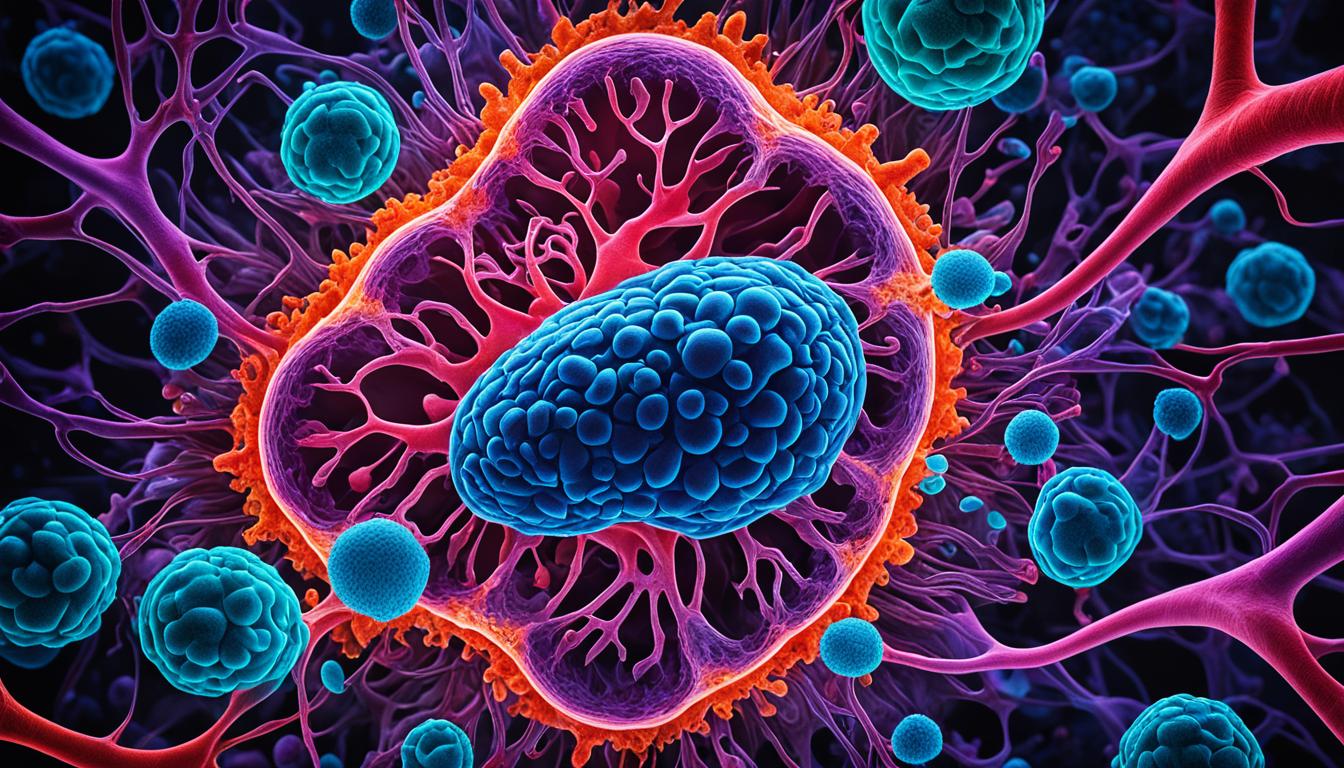Liver disease often comes after a hematopoietic stem cell transplant. Causes range from graft-versus-host disease to viral hepatitis. Liver enlargement, or hepatomegaly, is a top sign of liver trouble.
The diagnosis looks at features like “hyperbilirubinemia.” This means too much bilirubin in the blood, showing up as jaundice. Other signs are a swollen, painful liver and holding too much fluid. Scans help, and sometimes a liver biopsy is needed.
While liver disease can be hard, stem cell therapy offers hope. It uses cells from bone marrow, cord blood, or fat to fix liver damage. These cells change into liver cells and help with healing.
Our liver keeps us healthy by filtering toxins and doing many important jobs. It’s key to know how to spot and treat liver problems early. This knowledge can make a big difference in recovery.
Key Takeaways:
- Liver enlargement, or hepatomegaly, is a common symptom of liver disease.
- Clinical features such as hyperbilirubinemia, painful hepatomegaly, and fluid retention aid in the diagnosis of liver disease.
- Imaging tests like ultrasonography can confirm hepatomegaly and ascites.
- Liver biopsy may be necessary to differentiate liver disease from other conditions.
- Stem cell therapy is an innovative treatment option for liver disease, promoting tissue healing and regeneration.
Causes of Liver Enlargement
Liver enlargement, or hepatomegaly, has many causes. These include infections like Hepatitis A, B, and C.
- Autoimmune liver diseases such as autoimmune hepatitis can make the liver larger.
- Genetic liver diseases like Hemochromatosis may also lead to hepatomegaly.
- Conditions such as liver cancer and bile duct cancer can cause the liver to enlarge.
- A benign tumor in the liver, known as a liver adenoma, is another cause of hepatomegaly.
- Excessive long-term alcohol use can also result in liver enlargement.
- Issues like nonalcoholic fatty liver disease, often linked to obesity, might cause the liver to get bigger.
- Certain medications or exposure to toxins can lead to liver enlargement as well.
If your liver is enlarged, don’t ignore it. See a doctor to find the real cause and get the right treatment.
| Cause | Description |
|---|---|
| Infections | Hepatitis A, B, and C |
| Autoimmune liver diseases | Autoimmune hepatitis, primary biliary cholangitis, primary sclerosing cholangitis |
| Genetic liver diseases | Hemochromatosis, Wilson’s disease |
| Liver cancer | Primary liver cancer, metastatic cancer |
| Bile duct cancer | Cholangiocarcinoma |
| Liver adenoma | Benign liver tumor |
| Long-term alcohol use | Excessive alcohol consumption |
| Nonalcoholic fatty liver disease | Accumulation of fat in the liver |
| Certain medications | Medications with liver enlargement as a side effect |
| Toxins or chemicals | Exposure to harmful substances |
Symptoms and Diagnosis of Liver Enlargement
Liver enlargement, or hepatomegaly, can have no symptoms sometimes. But if you do have symptoms, they might point to liver problems. Signs like yellow skin, abdominal pain, and feeling bloated are common.
- Jaundice: Yellowing of the skin and eyes due to elevated bilirubin levels.
- Abdominal pain and swelling: Discomfort and bloating in the abdominal area.
- Swelling in the legs and ankles: Known as edema, it can be a sign of fluid retention.
- Itching: Persistent itching of the skin, also known as pruritus.
- Dark urine: Urine appears darker than usual due to excess bilirubin.
- Pale stools: Stools may lose their normal color and appear pale or clay-colored.
- Fatigue: Feeling tired and lacking energy, even with sufficient rest.
- Nausea: A queasy feeling in the stomach that may lead to vomiting.
- Loss of appetite: A reduced desire to eat, resulting in weight loss.
- Easy bruising or bleeding: Unexplained bruises and prolonged bleeding.
Diagnosing liver enlargement is crucial when symptoms appear. A doctor will try to figure out why the liver is enlarged. They may start by looking at your medical history and doing a physical exam.
- Clinical evaluation: Assessing the patient’s medical history, symptoms, and physical examination.
- Blood tests: Measuring liver function and enzyme levels, including liver enzymes, bilirubin, and clotting factors.
- Imaging tests: Utilizing ultrasonography to visualize the liver and detect any abnormalities.
- Liver Biopsy: Occasionally, a liver biopsy may be necessary to obtain a tissue sample for further examination and to differentiate liver disease from other conditions.
Using tests like blood work and ultrasounds helps find the cause of liver enlargement. Skills like these are vital for doctors to treat the issue successfully.
Stem Cell Therapy for Liver Enlargement
Stem cell therapy offers a new way to treat liver disease, including when the liver grows too big. It uses stem cells to fix and regrow damaged liver parts. These stem cells come from places like bone marrow, umbilical cord blood, or fat tissue.
These cells can turn into liver cells and help the liver heal. Studies show good results, like better liver function and smaller livers. But, we need more research to confirm it safely works.
As we learn more, stem cell therapy could be a game-changer for liver health. It might become a preferred choice for those who don’t want traditional treatments.

